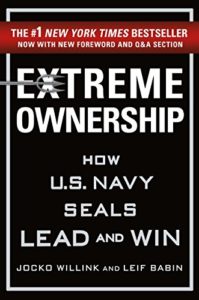Extreme Ownership
 Extreme Ownership: How U.S. Navy Seals LEAD and WIN
Extreme Ownership: How U.S. Navy Seals LEAD and WIN
By Jocko Willink and Leif Babin
ABOUT THE BOOK:
Click Here To Purchase From Amazon.
(From back page… hard to beat this…)
“Leif Babin and Jocko Willink served together as U.S. Navy SEAL officers in SEAL Team Three’s Task Unit Bruiser through the Battle of Ramadi, some of the toughest, sustained urban combat in the history of the SEAL Teams. Their task unit remains the most highly decorated special operations unit of the Iraq War. Upon their return, Babin and Willink developed and led Navy SEAL leadership training for SEALs deploying to Iraq & Afghanistan. They now lead a powerful leadership consulting company, Echelon Front, which teaches others how to build, train, and lead their own high performance, winning teams.”
Until very recently, Jocko Willink has led a very private life since returning from war. His leadership skills & implementation of leadership skills are 2nd to none, which is why companies & teams across the country contract he & Leif Babin.
Jocko’s 1st step into the public scene was in an interview on The Tim Ferris Podcast. Since that interview & others, Jocko has gone on to start his own wildly popular podcast. It is from these podcasts that a plethora of motivational style videos have come. My favorite is simply titled “Good.”
The video at the top of the page is from a TED Talk that Jocko gave in 2017. This story lays the foundation of the book.
Finally… Let’s talk about the book…
Note: I’m a big fan of audio books. It’s actually 1 of my secret weapons for getting through books a faster… hello 1.5x speed!!! I’d highly recommend you listen to this book. If you can’t tell from the video above, there is an intensity to both Jocko & Leif that comes through your headphones that you will love!
The book is broken into 3 Parts…
- Part 1: Winning the War Within
- Part 2: Laws of Combat
- Part 3: Sustaining Victory
Within every Part are 4 chapters. Every chapter follows the same format… A real life combat story (protecting classified information) that exemplifies a specific leadership lesson, immediately followed by that lessons “Application to Business.”
When I’m reading any book on business or leadership I’m always thinking about how it might apply to a single prospect, a full team or a coaching staff. In short, I’d recommend “Extreme Ownership” to any player, team or coach.
Extreme ownership means stepping up & taking responsibility for the good, the bad & the ugly. If you are the leader, you are ultimately responsible… responsible for everything! Period.
While the book expands on a dozen different leadership lessons that can all be applied on the ball field, I’d like to highlight just a couple here.
I’ve spoken in the past about the importance of a plan.
They dedicate an entire chapter to the concept. I’ll pull out an excerpt that you should print & post in the locker room for all to see.
“A leader’s checklist for planning should include the following:
• Analyze the mission. —Understand higher headquarters’ mission, Commander’s Intent, and endstate (the goal). —Identify and state your own Commander’s Intent and endstate for the specific mission.
• Identify personnel, assets, resources, and time available.
• Decentralize the planning process. —Empower key leaders within the team to
analyse possible courses of action.
• Determine a specific course of action. —Lean toward selecting the simplest
course of action. —Focus efforts on the best course of action.
• Empower key leaders to develop the plan for the selected course of action.
• Plan for likely contingencies through each phase of the operation.
• Mitigate risks that can be controlled as much as possible.
• Delegate portions of the plan and brief to key junior leaders. —Stand back and
be the tactical genius.
• Continually check and question the plan against emerging information to ensure
it still fits the situation.
• Brief the plan to all participants and supporting assets. —Emphasize
Commander’s Intent.
• Ask questions and engage in discussion and interaction with the team to ensure
they understand. 5
• Conduct post-operational debrief after execution. —Analyze lessons learned and implement them in future planning.”
The final chapter is called “Discipline Equals Freedom” (side note, that’s the name of Jocko’s newest book… get that too!).
In this chapter, Jocko lays out what he describes as the “Dichotomy of Leadership” which made me think about current & past leaders that I’ve been around. The best leaders have all shown many if not all of these characteristics.
“The Dichotomy of Leadership
A good leader must be:
- confident but not cocky;
- courageous but not foolhardy;
- competitive but a gracious loser;
- attentive to details but not obsessed by them;
- strong but have endurance;
- a leader and a follower;
- humble not passive;
- aggressive not overbearing;
- quiet not silent;
- calm but not robotic, logical but not devoid of emotions;
- close with troops but not so close that one becomes more important than another or more important than the good of the team; not so close that they forget who is in charge.
- able to execute Extreme Ownership, while exercising Decentralized Command.
A good leader has nothing to prove, but everything to prove.”
Surround yourself with teammates that sound like that list and you are well on your way to victory.
I hope you enjoy this book.
Click Here To Purchase From Amazon.
Links:
https://www.echelonfront.com/
http://jockopodcast.com
Leif Babin on Twitter at https://twitter.com/LeifBabin
Jocko Willink on Twitter at https://twitter.com/jockowillink